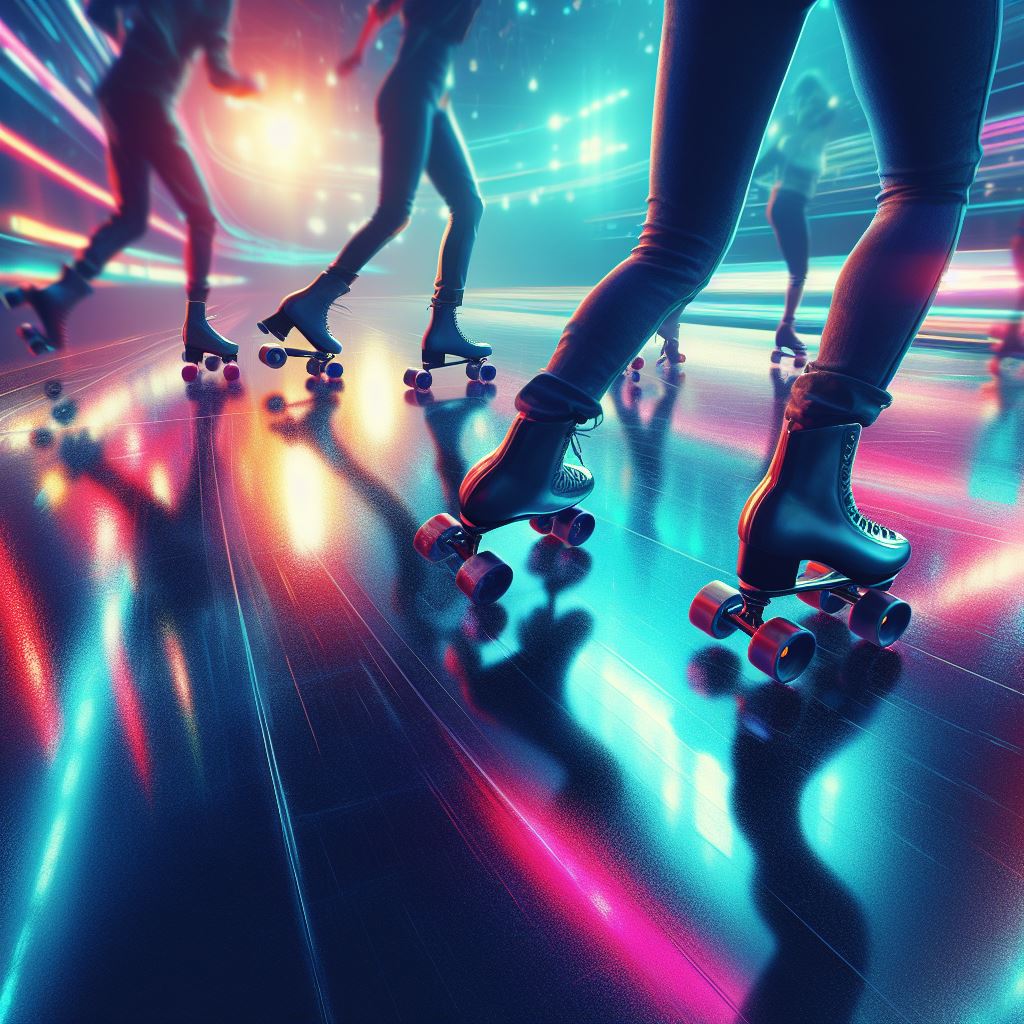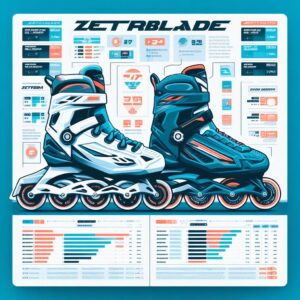Looking to find the best roller skating surface? Well, look no further! Did you know that the right surface can make all the difference in your skating experience? Whether you struggle with slippery surfaces or lack of control, we’ve got you covered.
In this article, we’ll uncover the best roller skating surfaces. From smoothness and grip to hardness and durability, we’ll explore the key factors that will take your skating game to new heights.
Key Roller Skating Surface Materials
Below are the key roller skating surfaces.
1. Indoor Surfaces
When it comes to indoor roller skating surfaces, there are three key materials to consider: wood, sport court/synthetic flooring, and polyurethane coatings.
Wood
For the best roller skating experience on indoor surfaces, choose wood as the key roller skating surface material.
Wood floors provide the ideal combination of smoothness, grip, and durability.
The smooth surface of wood flooring allows your wheels to roll and glide easily, giving you the freedom to move with ease.
Wood also offers a good grip, allowing for starts, stops, turns, and tricks.
Additionally, wood is a durable option, able to withstand repeated impact on roller skating rink floors.
Sport court/Synthetic flooring
Consider sport court or synthetic flooring for a versatile and durable option that enhances your roller skating experience.
Sport court, a type of synthetic flooring, offers a smooth and glossy surface with a low coefficient of friction, providing optimal smoothness for gliding.
While it may be slippery, the sport court is known for its durability, making it ideal for high-impact roller skating activities.
Polyurethane coatings
To optimize indoor roller skating surfaces, consider utilizing polyurethane coatings for a smooth and durable experience. Polyurethane coatings offer several benefits for roller skating surfaces:
- Enhanced grip: Polyurethane coatings provide excellent grip for skate wheels, allowing for better control and maneuverability.
- Smooth roll: The smooth surface of polyurethane coatings allows for effortless gliding and reduces friction, resulting in a smoother and more enjoyable skating experience.
- Durability: Polyurethane coatings are highly durable and can withstand repeated impacts without damage, making them an ideal choice for long-lasting indoor roller skating surfaces.
2. Outdoor Surfaces
When it comes to outdoor roller skating surfaces, two key materials to consider are concrete and asphalt.
Concrete
Concrete surfaces are prone to cracking and roughness over time, but they can still provide a suitable roller skating experience outdoors. When it comes to roller skating on concrete floors, here are three important things to consider:
- Surface smoothness: Concrete flooring may not be as smooth as other surfaces, affecting the overall skating experience.
- Grip: Concrete surfaces tend to have a lower coefficient of friction, meaning they may be slippery and offer less grip for your roller skates.
- Durability: Concrete flooring is known for its durability and can withstand the repeated impacts of roller skating.
While concrete may not offer the smoothest or grippiest skating experience, it’s still a viable option for outdoor surfaces.
Asphalt
If you’re looking for a roller skating surface that provides a smoother and more grippy experience than concrete, asphalt is a great option for outdoor surfaces.
Asphalt offers a smooth surface for outdoor skating, enhancing skating performance. It has a gloss meter reading of 15-40 GU, a surface profile of 0.2 to 0.5mm, and a coefficient of friction around 0.7, offering decent grip.
With asphalt, you can enjoy the freedom of skating outdoors on a smooth surface. It’s on of the best surface materials for a skatepark.
The Role of Wheels and Bearings
Now, let’s delve into the crucial role of wheels and bearings in achieving the optimal roller skating experience.
Wheel hardness – grip vs. slip
The hardness of the wheels plays a crucial role in the skater’s ability to maintain control and freedom on the surface.
Hard wheels provide less grip but more speed, allowing skaters to glide effortlessly across the surface.
Softer wheels, on the other hand, offer more grip, ensuring better traction for starts, stops, turns, and tricks, but may slow down the skater’s speed.
Finding the right balance between grip and slip is essential for an optimal skating experience. It’s recommended to match the wheel hardness to the surface smoothness and grip to achieve the desired level of control and freedom.
Bearing guide – influence on the speed
Bearings determine how fast you can go on the roller skating surface. They reduce friction between the wheels and the axle, allowing smooth and efficient rotation.
The quality of the bearings directly affects your speed and overall skating experience. High-quality bearings with a lower ABEC rating (such as ABEC-7 or ABEC-9) are designed for speed and are ideal for skating rinks or smooth surfaces. They provide less friction and allow the wheels to spin faster, maximizing your speed.
On the other hand, lower-quality bearings with a higher ABEC rating (such as ABEC-1 or ABEC-3) may not provide the same level of speed and smoothness.
Matching wheels to the surface material
When optimizing your roller skating experience, it’s important to match your wheels to the specific surface material you’ll be skating on.
The type of flooring you encounter, whether in roller skating rinks or outdoor environments, greatly affects your performance.
Here are three key factors to consider when selecting wheels:
- Wheel Grip: The level of grip your wheels provide is crucial for maintaining control during starts, stops, turns, and tricks. Softer wheels and surfaces offer more grip, while harder ones prioritize speed over control.
- Type of Flooring: Different surfaces, such as wood, concrete, asphalt, or sports court, have varying smoothness and grip characteristics. Understanding the specific qualities of each type will help you choose the most suitable wheels.
- Indoor vs. Outdoor Wheels: Indoor skating on maple wood floors requires wheels with good grip and smoothness. Outdoor wheels, on the other hand, need to be more durable and able to handle rougher surfaces like asphalt.
Comparing Key Surface Attributes.
Table comparing smoothness, grip, and hardness of top surfaces
When comparing the smoothness, grip, and hardness of top roller skating surfaces, it’s important to consider various key surface attributes.
These attributes include:
- Smoothness: A smooth surface allows wheels to roll and glide easily, reducing friction and vibration. Key smoothness measures include gloss meter readings, surface profile depth, and flatness.
- Grip: The right grip is essential for starts, stops, turns, and tricks. Too much grip can hinder speed and fluid motions. Grip is measured by the coefficient of friction, with softer surfaces and wheels offering more grip.
- Hardness: The hardness of a surface affects both speed and control. Harder surfaces provide speed but less control, while softer surfaces offer more grip but slow skaters down. Hardness is quantified using hardness durometers, with wood, concrete, and asphalt having different hardness ranges.
Recommendations for different skating styles (artistic, speed, etc.)
For artistic skating, a smooth surface is crucial for gliding and executing intricate footwork. Opt for a roller skating surface with a high gloss meter reading and a surface profile depth of around 0.15mm for a smooth finish. A coefficient of friction between 0.5 and 0.8 will provide a good grip for turns and tricks.
For speed skating, prioritize a surface with less grip to maximize speed and fluid motions. Choose a surface with a lower coefficient of friction, around 0.5, and a harder surface with a higher Brinell hardness rating.
Remember that the specific surface should match the skating style to optimize performance and enjoyment.
Maintaining Skating Surfaces
To maintain optimal roller skating surfaces, it’s crucial to protect and repair concrete and asphalt surfaces.
Protecting and repairing concrete and asphalt surfaces
To maintain your roller skating surfaces, it’s essential to know how to protect and repair concrete and asphalt using the proper techniques. Here are three key factors to consider:
- Material: Choose high-quality materials specifically designed for protecting and repairing concrete and asphalt surfaces. These materials should have excellent durability and withstand the wear and tear of roller skating.
- Weather Conditions: Take into account the weather conditions in your area. Extreme temperatures, moisture, and UV rays can all cause damage to the skating surfaces. Select coating materials resistant to these weather conditions to ensure long-lasting protection.
- Cost Estimates: Consider the cost of protecting and repairing concrete and asphalt surfaces. Factor in the initial cost of materials, as well as the potential costs of future repairs and maintenance. It’s important to balance cost and effectiveness to ensure the longevity of your skating surfaces.
Refinishing wood rinks
Maintain your wood rink’s skating surface by refinishing it regularly. Refinishing not only enhances the appearance of your wood rink but also prolongs its lifespan and ensures optimal performance.
When refinishing wood rinks, there are several flooring options to consider. The following table provides a comparison of different flooring options for wood rinks:
| Flooring Options | Smoothness (Gloss Meter Reading) | Grip (Coefficient of Friction) |
|---|---|---|
| Maple | 80-100 GU | 0.5-0.8 |
| Concrete | 10-50 GU | 0.5 |
| Asphalt | 15-40 GU | 0.7 |
| Sport Court | Up to 100 GU | Low |
To refinish your wood rink, you can seek design assistance from professionals who specialize in roller skating surfaces. They can guide you through the process and help you choose the right refinishing products and techniques for your wood rink.
Refinishing your wood rink regularly, you can maintain its smoothness, grip, and overall quality, ensuring a fantastic skating experience for you and your fellow skaters.
So, take the necessary steps to keep your wood rink in top condition and enjoy the freedom of gliding effortlessly on a well-maintained surface.
Cleaning debris from outdoor surfaces
Clean the debris from outdoor skating surfaces to maintain a smooth and enjoyable skating experience. Regular cleaning helps prevent damage to the surface and ensures optimal performance.
Here are three important steps to follow when cleaning your outdoor skating surface:
- Sweep the surface: Use a broom or a leaf blower to remove loose debris such as leaves, dirt, and small rocks. This will prevent these particles from interfering with your skating and causing accidents.
- Power wash the surface: Use a power washer to remove stubborn dirt, grime, and stains. Adjust the pressure settings according to the surface type to avoid causing any damage.
- Inspect and repair: After cleaning, carefully inspect the surface for any cracks, holes, or other damage. Repair any issues promptly to prevent further deterioration.
Frequently Asked Questions
How Do Different Roller Skating Surfaces Affect the Overall Skating Experience?
Different roller skating surfaces affect your overall experience. Smoothness allows easy gliding, while grip enables starts, stops, and turns. Harder surfaces provide speed but less control, while softer surfaces offer more grip. Durability is crucial for long-lasting enjoyment.
What Are the Key Factors to Consider When Choosing a Roller Skating Surface?
Consider smoothness, grip, hardness, and durability when choosing a roller skating surface. Smoothness allows easy rolling, while grip enables control. Harder surfaces offer speed, but softer surfaces provide more grip. Durability is important for withstanding impact.
What Are the Recommended Maintenance Practices for Different Roller Skating Surfaces?
To maintain different roller skating surfaces, clean debris on smooth asphalt outdoors, regularly refinish maple wood indoors, and deep clean sport court floors. Match wheels to surface smoothness and grip for optimal performance.
How Do the Hardness and Grip of a Roller Skating Surface Impact Skaters’ Speed and Control?
The hardness and grip of a roller skating surface greatly affect your speed and control. Harder surfaces provide more speed but less control, while softer surfaces offer more grip but slow you down.
What Are the Advantages and Disadvantages of Indoor and Outdoor Roller Skating Surfaces?
Indoor and outdoor roller skating surfaces have pros and cons. Indoors, maple wood offers smoothness and grip. Outdoors and smooth asphalt are ideal but watch for cracks and debris. Match wheels for optimal performance. Enjoy your freedom on wheels!
Best surface for roller skating | Key Takeaways
- Smoothness is crucial for a good roller skating experience, as it allows wheels to roll easily and reduces friction.
- Grip is important for starts, stops, turns, and tricks, but too much grip can hinder speed and fluid motions.
- Harder surfaces provide speed but less control, while softer surfaces offer more grip but slow skaters down.
- Durability is essential as surfaces must withstand repeated impacts, and outdoor surfaces are subject to weathering.



